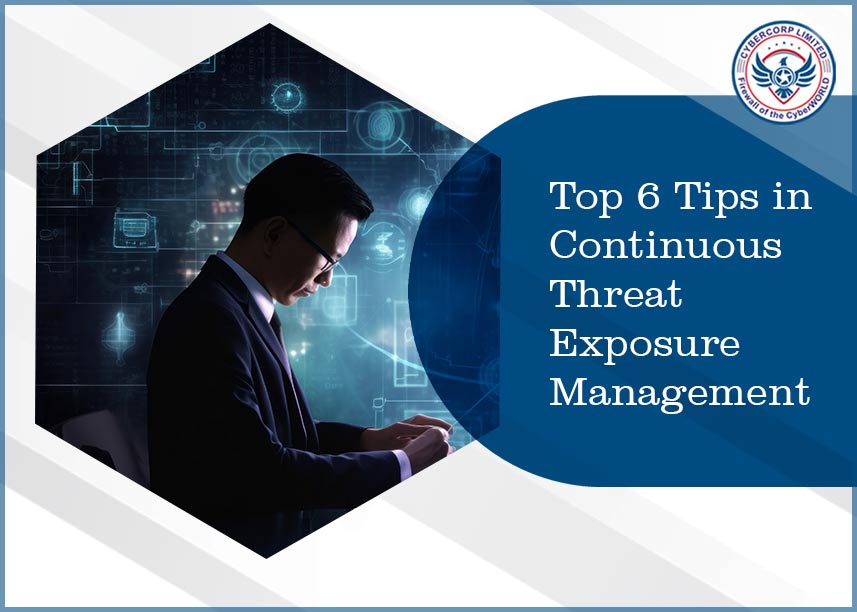
Top 6 Tips in Continuous Threat Exposure Management

In today's digital environment, where cyber security threats are constantly evolving and becoming more sophisticated, organizations must take proactive approaches to effectively manage and mitigate risk. Continuous Threat Exposure Management (CTEM) has emerged as an essential strategy for real-time detection, prioritization and remediation of vulnerabilities. In this blog post, we explore six important tips to improve your organization's CTEM practices and strengthen its security.
1. Implement automation and instrumentation
Automation plays a key role in streamlining threat management processes by eliminating manual tasks and speeding response times. Use automation tools and orchestration platforms to automate routine security tasks such as vulnerability scanning, patching and incident response. By automating these processes, organizations can reduce human error, increase efficiency and respond more effectively to threats.
2. Enable real-time monitoring and detection
Continuous monitoring and detection capabilities are essential to detect new threats and vulnerabilities in real-time. Deploy robust security monitoring solutions that provide comprehensive visibility into network activity, system logs, and user behavior. Use threat intelligence and anomaly detection algorithms to proactively detect and respond to suspicious activity or signs of compromise before they develop into full security breaches.
3. Prioritize Vulnerability Patching
Not all vulnerabilities are created equal, and prioritizing remediation efforts is critical to effective threat management. Use a risk-based approach to vulnerability management, prioritizing vulnerabilities based on their severity, usability and potential impact on critical resources and systems. Focus on fixing high-risk vulnerabilities first to reduce the most significant security threats and reduce the attack surface.
4. Promote collaboration and communication
Effective risk management requires collaboration and communication between the organization's various teams and stakeholders. Establish clear lines of communication between IT, security and business units to ensure timely sharing of threat information, incident response procedures and remedial actions. Encourages cross-functional collaboration and information sharing to promote security awareness and a shared culture of defense against cyber threats.
5. Conduct regular security assessments and tests
Regular security assessments and tests are essential to identify weaknesses in your organization's security posture and increase the effectiveness of existing controls. Conduct deep vulnerability assessments, penetration testing, and red team exercises to identify potential vulnerabilities and simulate real-world attack scenarios. Use the results of these assessments to refine your security management, prioritize remediation efforts, and improve your overall resilience to cyber threats.
6. Stay informed and adaptable
Cyber security threats are constantly evolving and organizations must stay informed and adaptable to effectively manage threats. With continuous threat intelligence collection and information channels, you can stay up-to-date on the latest security trends, new threats and best practices. Regularly review and update your security policies, procedures and management tools to proactively combat new and evolving threats. Foster a culture of continuous learning and improvement so you can effectively adapt to an ever-changing threat landscape.
Conclusion
In conclusion, continuous threat management is a critical component of today's cybersecurity strategies, enabling organizations to identify, prioritize, and mitigate security risks in real time. By implementing automation and instrumentation, deploying real-time monitoring and detection capabilities, prioritizing vulnerability remediation, fostering collaboration, vulnerability management tools and communication, conducting regular security assessments and tests, and staying informed and adaptable, organizations can strengthen their defenses and effectively manage the dynamic nature of cyber technology threats. By following these six tips, organizations can improve their CTEM practices and better protect their assets, data and reputation in an increasingly hostile digital environment. Contact CyberCorp for external attack surface management to maintain the utmost safety and secure the entire system.
Categories
Trending Posts
-
Security Update
Supply Chain Cybersecurity: How to Secure Your Extended Network -
Security Update
A Guide to Endpoint Security: What You Need to Know -
Security Update
Top 10 Tools Every Cyber Security Professional Should Know -
Security Update
Exploring the Role of Ethical Hackers in Cyber Security -
Security Update
10 Practical Cyber Security Tips Everyone Should Know -
Security Update
How Blockchain is Revolutionizing Cybersecurity
Why CyberCorp is not a mere SPAC?

We are

CoOperative Corporate
Creates a commonwealth among the partners
Cumulative Growth safeguards against losses to one entity
We believe in

Organic Growth
Promotes growth within the group companies
Ensures Maximum benefits
We do

Integration
Horizontal integration of the various products
Creating new and more effective scalable solutions
© 2022-2024 CyberCorp Limited. All Rights Reserved.







.png)

